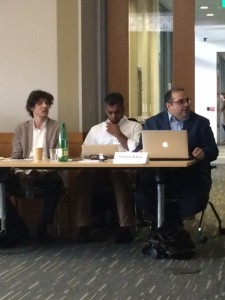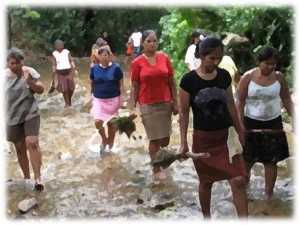Our “On The Market” series is back, featuring 5th-year doctoral candidate and Urban Ethnography Lab fellow, Pamela Neumann:

Tell me about your research. What have you been working on?
Really broadly, I consider my research to be at the intersection of gender and political sociology. Empirically, my work looks at the dynamics of the state and social movements in Latin America, and theoretically it’s about issues related to gender and power. I started out doing research on women’s participation in development programs in Nicaragua and how that was affecting their lives. I was fortunate to publish that research a few years later.
Then, I worked on a project (as part of an NSF grant that Javier Auyero spearheaded) comparing perceptions of environmental risk in three different countries in Latin America. My piece of that was in Peru, in a small town called La Oroya. I was looking at why more people weren’t mobilizing against this 90-year old lead smelter that had caused so much contamination in the community. Many people work for the company, so that was one reason people weren’t mobilizing; but I was trying to figure out what some alternative explanations might be as well.
For my dissertation, I’m writing about violence against women, feminist activism, and state practice in Nicaragua. What happens when women try to place a legal claim against an abusive partner or someone else? What obstacles do they they face in the midst of that? I also look at local feminist mobilization around the issue of violence against women, and the dynamics of these interactions between women’s organizations and the state.
Where do you see your research going?
In the future, what I’m hoping to do is some more comparative work in Latin America, both related to violence against women and collective action. I’m particularly interested in places where extractive industry is increasing – in Peru, for example, where there are a lot of new open pit copper mines – and trying to explain when and how people mobilize in those settings against those kinds of projects and also, the gender dynamics in those communities.
Sounds like really complex and interesting work. So, how have you been preparing for this process of going on the market?
One of the first steps was to write a lot of drafts of things like research statements and teaching statements, trying to figure out how to articulate what my project is about beyond the case itself and what kinds of contributions I’m making to the subfields I’m in conversation with. I worked to figure out what those arguments are and then to synthesize them into a few key paragraphs. One thing I spent a lot of time thinking about was: what is the role of feminist activism on the issue of violence against women? Is it effective? In what ways? Is it not effective? And how does that compare or contrast with what women’s actual experiences are, because I feel like sometimes there’s a disconnect between feminist activism and the lived experiences of women. Activists have a particular point of view, priorities and strategies for what they think needs to happen, but for example, in my research I found that a lot of women didn’t necessarily want their partners to be incarcerated. You know, what does that say about feminist activism that’s all about getting laws changed or getting higher legal penalties for these crimes. I’m definitely not saying these crimes shouldn’t be penalized, but why is it that these are the main strategies being used? So, it’s a larger question about how activists try to promote social justice. Are legal strategies always the best?
So, I had to step back from the particularities of women’s situations in Nicaragua to ask a bigger question about the theoretical implications of what I’m doing. That’s one thing. The other big, theoretical issue I thought about as I was preparing my materials is about the state and how the state operates. A lot of how we talk about the state is high-level and kind of monolithic; I was thinking, what is my contribution to that debate, looking at low-level actors like police and prosecutors and the power and influence that they wield in these situations?
So, you spent a lot of time thinking about how to present yourself and your work. Situating where you’re engaging with these broad, sociological questions. When did you start working on materials?
I started writing drafts of my statements this summer, around June when I kind of knew – I had been advised – that I should start preparing. I was assisted by the fact that there were some July deadlines. This is something to be aware of if you’re going to go on the market, there could be deadlines as early as the middle of the summer. It’s good to start watching the ASA job bank, because some of the very early deadlines – July, late August, September 1 – were some of the main places that I wanted to apply. So, being ready by the beginning of the summer to send things out. Also, ASA falls at the end of August and well before that, there’s the ASA Employment Services that opens up– and those jobs start posting months before – so the sooner that you’re ready to send initial contact emails to those places with your updated CV, a brief description of your dissertation (a dissertation abstract) the better off you’re going to be.
How was it being on the market at ASA?
The key to being successful at the ASA-phase is to have already been thinking about this process well in advance and to have made contact with schools well before the Employment Services time period. The way it’s set up, you get 15 minutes with schools. Those schools look at your materials that you’ve already posted when you signed up for the service and they decided whether or not they’re going to contact you. The sooner you’re in the system, the sooner you can be on their radar, and the more likely it is that some of those schools are going to want to meet with you. I hadn’t received any advice early on one way or another about whether I should do that, so I didn’t sign up, unfortunately, until right when ASA started. Something else to be aware of is that you can’t see who the schools are who are signed up until you pay for the service. Many of these schools only send one or two people to ASA to do these interviews and there are potentially thousands of people submitting their materials. So, the sooner you’re on their radar, the sooner you can potentially get a slot.
You’re teaching a class this fall in addition to the doing all these applications and writing. How are you balancing all of your responsibilities?
That is a great question. I think teaching my own class this semester has been a challenge in that it requires a different kind of time management. As a TA, you’re not responsible for the lectures. I didn’t really have an idea of how long it would take to prepare a lecture until I actually had to do it. I learned early on that if I let myself, I could spend 8 hours preparing one lecture. After about two weeks of that, I realized that is not sustainable. So, I started to think: how I can make this process a little more efficient? At first, I spent a lot of time doing extra research but I realized I should focus on helping them learn what I actually assigned them to read. That’s what I can do right now. And I work on making the class interactive.
In terms of balancing, I dedicate Monday morning to prepping for my class and the afternoon, after I teach, to job applications. The days that I teach, that’s the pattern. Prep for class, teach, and job applications. At least two thirds of the day on Tuesday and Thursday, I try to devote to my dissertation, and at least one day of the weekend. So, it’s not ideal, but I guess it would help if I had a Tuesday-Thursday class. But, I’m very happy to be teaching; it’s been a great experience. I’ve learned a lot and it’s helped me write my teaching statement. This is the thing about preparing materials; it’s helpful to give concrete examples and the only way to get those examples is to have taught. I realize, now that I have been teaching for the last month, now I have really good stories that I can share not only in my materials, but in the event that I have the opportunity to interview somewhere. I definitely recommend if you have the opportunity to AI before going on the job market, to do it because it’s really helpful.
That’s great advice! What would be your biggest piece(s) of advice for those going on the market next year or the next few years?
I think I’ve said some of it already. It could be categorized into a few things, like writing your statements – research and teaching statements are only one to two pages long and it’s surprisingly difficult to write one to two really concise pages that are tightly woven and flow coherently. One piece of advice is don’t assume you’re going to be able to do that in your first draft. Even those of us who are good writers, who are practiced writers, it’s a different kind of thing to write. Give yourself a lot of time to do that. Don’t rush it.
Also, try to have some idea of what it is that you want, in terms of what you want to do when you’re done. Are you interested in primarily focusing on research? Are you interested in smaller, liberal arts colleges? Use what you know about yourself to inform how expansive or tailored your search is. I know some people think of their first year on the market as a “soft” search, where they’re really particular about where they apply and put “feelers” out. Other people say you should just apply widely and see what happens. I think it’s good practice and helpful to do a little bit of investigation about each school before you decide. Go to their website, look at who the faculty are, see what their research interests are and don’t think too much about “oh, it’s really cold there.” [laughs] You never know.
There are so many things you don’t have control over. In a way, it’s like what they say about publishing, you know you can’t take it personally. For example, now that I’ve been on the market for several months, I’ve already heard from a few places that I’m not on their list anymore. It’s important to remember that it isn’t necessarily because of my record, it could just be I’m not the kind of scholar they need right now. It’s the cliché thing – you’re not a good fit – but that could also be true. You have to try to not invest too much of your identity in the process.
One of the things I forgot to mention is one of the major parts of this whole process, the recommendation letters. If you’re going to apply to 30-60 schools, you’re probably going to want to use some sort of dossier service like Interfolio or Vitae. Investigate those and then, well before your deadlines, you want to make sure that you have identified three people who have already agreed to write for you, who know in advance where you’re applying, if you’re going to be periodically sending request emails. It’s important that they know to expect those emails; sometimes they go to junk mail. I didn’t have a clear idea of what professors would prefer in terms of the organization of the process until I was in it, so it’s good to find out how they want to handle that.
Also, definitely ask for examples of research and teaching statements and cover letters from people that you know or other people in the department. You can save yourself so much time, to at least see somebody’s final product. Not that your first draft has to be the same as whatever that person’s final draft was, but it’s helpful to see the organization, structure and the kinds of ways that people are framing their research to help you structure your own. That was really helpful to me.
How are you keeping all of this organized?
I’ve got a spreadsheet with all the school names and it had school name, deadline, the name of the position – because sometimes, it’s not just a sociology position, sometimes, it’s a joint – and then what they require from you, because not every school is the same. Some schools only want your cover letter and your CV, some want the CV and teaching statement, or just your research statement. Some want the letters of recommendation immediately. Some will contact your references later. So, have all that there. Once I’ve submitted I color-code it blue. I’ve been using Interfolio for the references, so I have a record of when the letters have been sent and to whom they’ve been sent. I save each individual cover letter for each school as a separate document and I have a couple different versions of my research statement and my teaching statement. I created a document that I thought would serve for the majority of schools and then I modify it for each application. I don’t have a separate folder for each school, but I know which versions of statements I send to each, the gender-specific versus just my standard statement.
Also, I didn’t think about this in the beginning, but don’t wait until the last minute to submit things. Anything can happen, you don’t know if the system is suddenly going to crash on you. So, you don’t’ want to be submitting your job applications at like 11:59pm the day before they’re due. Further, some schools start reviewing as the applications come in. So, if you can get your stuff in earlier, then it’s possible your application is going to get more attention. Also, if you’re submitting letters, you can’t submit at the last minute because your recommenders also need time to meet that deadline. So, you should really try to submit your applications a week before the deadline to give your recommenders time to upload the letters. Even if you’re using generic letters, Interfolio takes like a day.
When do you know that you’re ready to submit?
I sent multiple drafts to two professors to get feedback. With their feedback on the standard cover letter, the research statement and the teaching statement, basically I just tweak those documents on my own and don’t send the faculty any of those tweaked versions. They’ve approved the generic version, so whatever small things I might change for an individual school that isn’t something to bother the faculty with. In terms of knowing, I think it’s when the faculty that you’re working with say, “yeah, this is good.” I don’t think there’s really any other way to know. You start to realize what may be working as the process goes on. So, maybe in a few months I’ll know more, have more insight about that, to know what caught their attention. One thing I know is important is to have a clear puzzle in the letter. What is it you’re trying to explain? That’s not just a publication rule, that’s why should I care about your research, you know?
How are you practicing self-care?
I believe in self-care and so do my advisors. One way I like to practice self-care is through exercise. I like to go running, I go to the gym. Getting out all that physical energy, the stress that builds up. Also, I haven’t done this a lot but getting a massage periodically is also helpful. And of course, the occasional glass of wine. That hasn’t ever hurt anyone. Also, solidarity. Whoever is on the market with you, it’s helpful to talk to each other and share information. Yes, academia is a competitive place but we’re also each other’s future colleagues and our mutual success is important. I’m rooting for everyone in our department to get a job.
We’ve worked really hard for a long time and so it feels like it’s really high stakes. But at the end of the day, I’m still a person, and I have a life and that matters to me.




